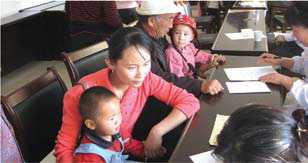Global Disease Detection Program: China

U.S. CDC rapidly translates scientific findings from the GDD programs into disease prevention recommendations for greater health impact.
The U.S. Centers for Disease Control and Prevention (U.S. CDC) has collaborated with public health institutions in China since the 1980s to address public health priorities that affect China, the United States, and the global community. U.S. CDC’s principal partners in China are the Ministry of Health (MOH), the Chinese Center for Disease Control and Prevention (China CDC), and the World Health Organization (WHO China).
China U.S. Collaborative Program on Emerging and Re-emerging Infectious Diseases
In 2005, the China MOH and the U.S. Department of Health and Human Services signed a Memorandum of Understanding to establish the China U.S. Collaborative Program on Emerging and Re-emerging Infectious Diseases (EID), which includes activities of the U.S. CDC, Food and Drug Administration, and National Institutes of Health. U.S. CDC’s component of the EID collaboration is largely funded by the U.S. CDC Global Disease Detection Program (GDD).
GDD is U.S. CDC’s principal program for identifying and containing emerging infectious diseases around the world, and has been designated by WHO as a Collaborating Center for Implementation of the International Health Regulations -- National Surveillance and Response Capacity. A central focus of GDD is the establishment and expansion of GDD Regional Centers in each WHO region.
The United States and China share public health priorities – including a coherent approach to detect and control emerging and re-emerging diseases.
Responding Jointly to Health Threats
In 2006, a China Center was established with collaborative projects extending across the country, building strong bilateral relationships between both countries through scientific exchange. U.S. CDC’s Global Disease Detection Program, which focuses on outbreak response, pathogen discovery, surveillance, training, and networking, provides the core support for U.S. CDC’s participation in this collaboration with China.
Connecting Resources to Build Capacity
Guided by joint priorities, the U.S. and China build capacity to detect and respond to emerging and re-emerging infectious diseases by connecting complementary programs and resources. This comprehensive approach helps China identify and contain infectious disease outbreaks before they spread globally. Programs include:
- Emerging Infections U.S. CDC and China CDC experts strengthen public health surveillance to prevent transmission of infections and improve laboratory detection of infectious diseases, such as acute respiratory infections, foodborne infections and drug-resistant tuberculosis.
- Epidemiology Capacity Building The Chinese Field Epidemiology Training Program (CFETP), a two-year field program, strengthens disease surveillance, applied epidemiology, and response capacities through a rigorous curriculum designed to train China’s future public health leaders.
- Influenza For more than 20 years, U.S. CDC has supported the Chinese national influenza laboratory, including a recently awarded WHO influenza reference laboratory. Today, partners combine expertise to prevent, identify, and control influenza through joint preparedness, surveillance, and rapid response activities.
- Laboratory Quality and Biosafety U.S. CDC expertise in China improves performance of infectious diseases laboratories, strengthens worker safety, and reduces the risk of accidentally releasing harmful substances.
- Health Communication U.S. CDC helps China mitigate public health threats and address public health priorities through the use of science-based communication strategies, risk communication principles, and new media channels.
Making a National Impact

U.S. CDC and its Chinese counterparts respond jointly to public health issues, including Hand, Foot, and Mouth Disease caused by enterovirus-71 and melamine in milk contamination.
From 2006-2015, U.S. CDC, with Chinese colleagues, developed a coordinated process with measurable progress in detecting and responding to emerging infectious diseases in China, including:
- Effective response to over 500 outbreaks
- Implementation of population-based pneumonia surveillance in Jinzhou, Hubei Province, covering 1 million lives
- Detection of three pathogens new to China
- Establishment of diagnostic testing capacity for 17 diseases or pathogens
- Graduation of 182 public health professionals through CFETP working in 27 of the 31 provinces, at the national level, and through international organizations
- Training of over 17,000 public health professionals through short-term exercises, including pandemic preparedness, rapid response, and epidemiology and laboratory training
- Improved health communication through training of nearly 5,000 provincial communicators on use of risk communication principles, new media channels, and emergency communication strategies
- Page last reviewed: April 4, 2016
- Page last updated: April 4, 2016
- Content source:


 ShareCompartir
ShareCompartir